Introduction
Extended School Year (ESY) programs are critical in providing ongoing education and therapy to students with disabilities during breaks. These programs go beyond being a mere stopgap; they are a strategic approach to ensure that children with unique learning needs do not lose hard-earned skills or fall behind their peers. With the growing representation of students with disabilities in public schools and the rise in disputes between families and school districts over special education services, the need for ESY programs becomes even more apparent.
ESY serves as a critical element in preventing skill regression during extended school breaks, contributing to better long-term outcomes for these students. By integrating technology solutions and incorporating research insights, ESY programs can be tailored to better serve students with disabilities, fostering the development of essential social and emotional skills. Ultimately, ESY programs are not a luxury but a necessity in the pursuit of equitable education, providing fair and equitable opportunities for every child to thrive.
What are ESY Programs?
Extended School Year (ESY) programs play a crucial role in supporting students with disabilities by providing ongoing education and therapy during breaks. These programs are not just a stopgap but a strategic approach to ensure that children with unique learning needs do not lose hard-earned skills or fall behind their peers. As Dr. David (Dan) R. Offord, a renowned child psychiatrist, emphasized, it is vital that all children, including those with disabilities, have fair and equitable opportunities to thrive in school, home, and leisure activities. These opportunities are especially significant for students engaged in Applied Behavior Analysis (ABA) therapy, as consistent practice is key to their progress.
Recent findings from the U.S. Department of Education highlight the growing representation of students with disabilities in public schools and underscore the importance of addressing their distinct educational needs. With the noted rise in disputes between families and school districts over special education services, as reported by the Center for Appropriate Dispute Resolution in Special Education (CADRE), the need for programs like ESY becomes even more apparent. ESY serves as a critical element that can prevent skill regression during extended school breaks, thereby contributing to better long-term outcomes for these students and potentially reducing the need for dispute resolution processes.
Moreover, the advancement of technology solutions in educational settings, as noted by a Board-Certified Behavior Analyst with extensive clinical experience, can facilitate high-quality, coordinated care, and streamline the review processes for students with disabilities. By integrating such technology within ESY programs, educators can enhance the effectiveness of these interventions, ensuring that each child continues to receive the necessary support, even outside the conventional school year.
Incorporating research insights into ESY programs can also help tailor these interventions to better serve students with disabilities. As studies have shown, social and emotional skills are integral to success in various life domains, and understanding the unique ways these skills impact students with disabilities is key to optimizing their learning experiences. ESY programs, therefore, must be informed by such evidence to foster the development of these essential skills.
Ultimately, ESY programs are not a luxury but a necessity in the pursuit of equitable education. They are a testament to a society's commitment to 'making the race fair' for every child, as envisioned by Dr. Offord, by recognizing their needs, reducing stressors, and equipping caregivers with the resources to support their children's development.
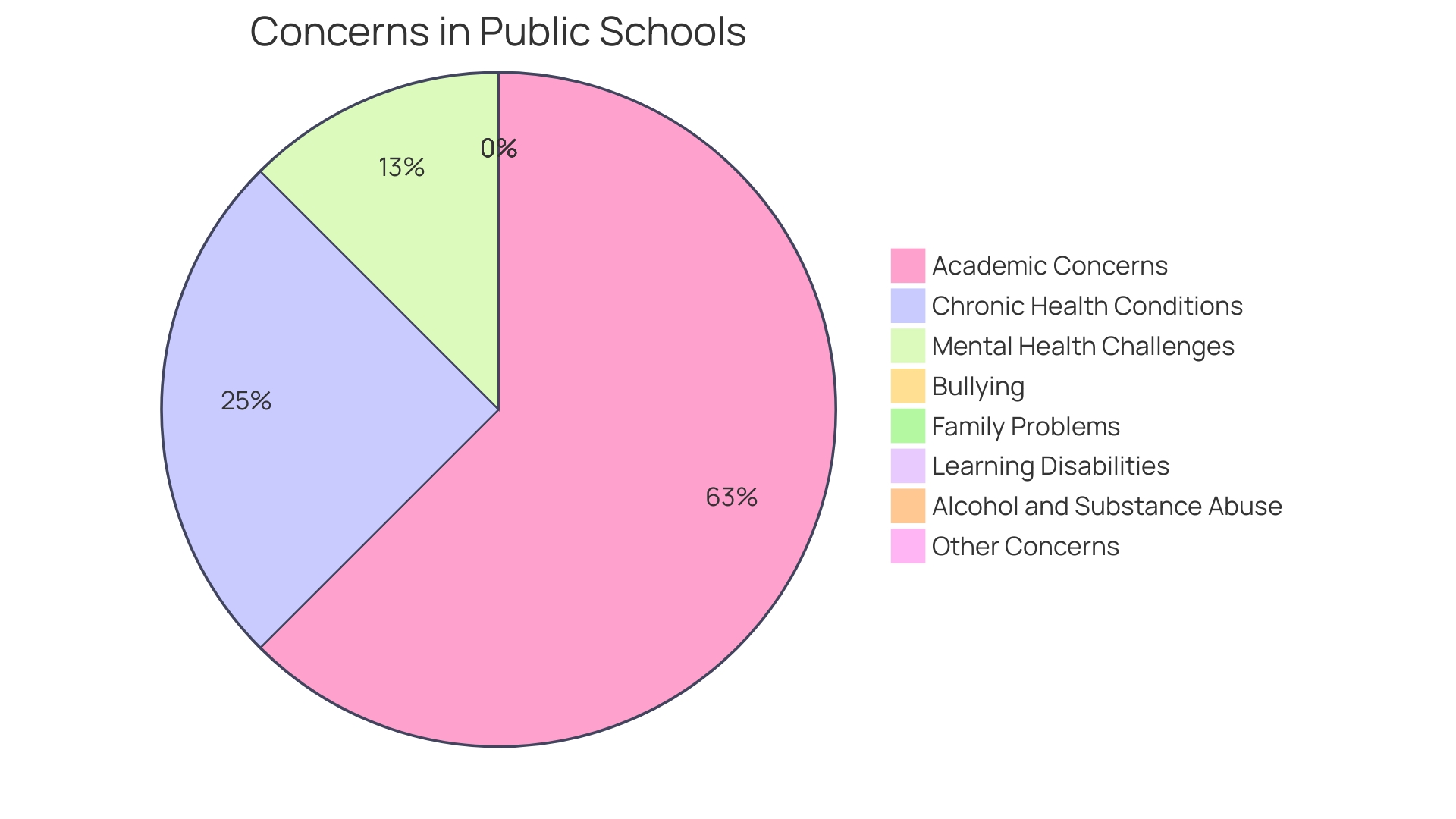
Why are ESY Programs Necessary?
Extended School Year (ESY) programs are crucial in supporting students who benefit from ABA therapy, especially during prolonged breaks from school. These programs are more than just a stopgap; they are lifelines that prevent the erosion of hard-earned skills and behaviors. By offering a stable and structured setting, ESY programs enable continuous progress towards individualized educational goals and specialized interventions. This consistent engagement is key in reducing the risk of regression and fostering ongoing development, effectively bridging the gap between academic years.
Incorporating the best practices from evidence-based programs, such as the Incredible Years Teacher Classroom Management (IY-TCM) program, ESY services can be optimized for effectiveness. Research has shown that careful implementation of such programs, tailored to the social and emotional competencies of children, can significantly impact their development. For instance, the Academias Gulbenkian do Conhecimento initiative has demonstrated successful implementation of social and emotional learning strategies across various educational settings in Portugal, reinforcing the value of adaptability and self-regulation in children and young adults.
As the prevalence of autism spectrum disorders increases, with current estimates at 1 in 36 children, the need for nuanced and varied approaches to intervention becomes more apparent. Dr. Jan Blacher's insights highlight the diversity within the autism spectrum and the necessity for interventions like ESY programs to be flexible and tailored to individual needs. By maintaining service delivery throughout the year, ESY programs ensure that each child's unique developmental trajectory is supported, promoting equitable opportunities for growth and learning.
With the right implementation strategies in place, including technology solutions that streamline care coordination, ESY programs can become even more effective. This focus on quality and coordinated care is key to maximizing the potential of students receiving ABA therapy, ensuring that their progress is not only maintained but also built upon during school breaks.
Determining Eligibility for ESY Services
The process of determining a student's need for Extended School Year (ESY) services is intricate and tailored to each child's unique requirements. It involves a thorough assessment that takes into account a range of factors, including the child's progress as outlined in their Individualized Education Program (IEP), ongoing progress monitoring, behavioral evaluations, and crucial insights from both parents and educators. This comprehensive evaluation aims to pinpoint students who may experience learning regression during extended breaks or those who might benefit from additional support to sustain the educational gains they have made. In light of the importance of inclusion, it's essential that this process also aligns with the legislative framework and recommendations set forth by the Individuals with Disabilities Education Act (IDEA), ensuring that children with disabilities have access to continuous learning opportunities. Moreover, it's critical to utilize current educational research and best practices in determining ESY eligibility, as highlighted by experts in the field, to maintain a high standard of educational continuity and quality care.
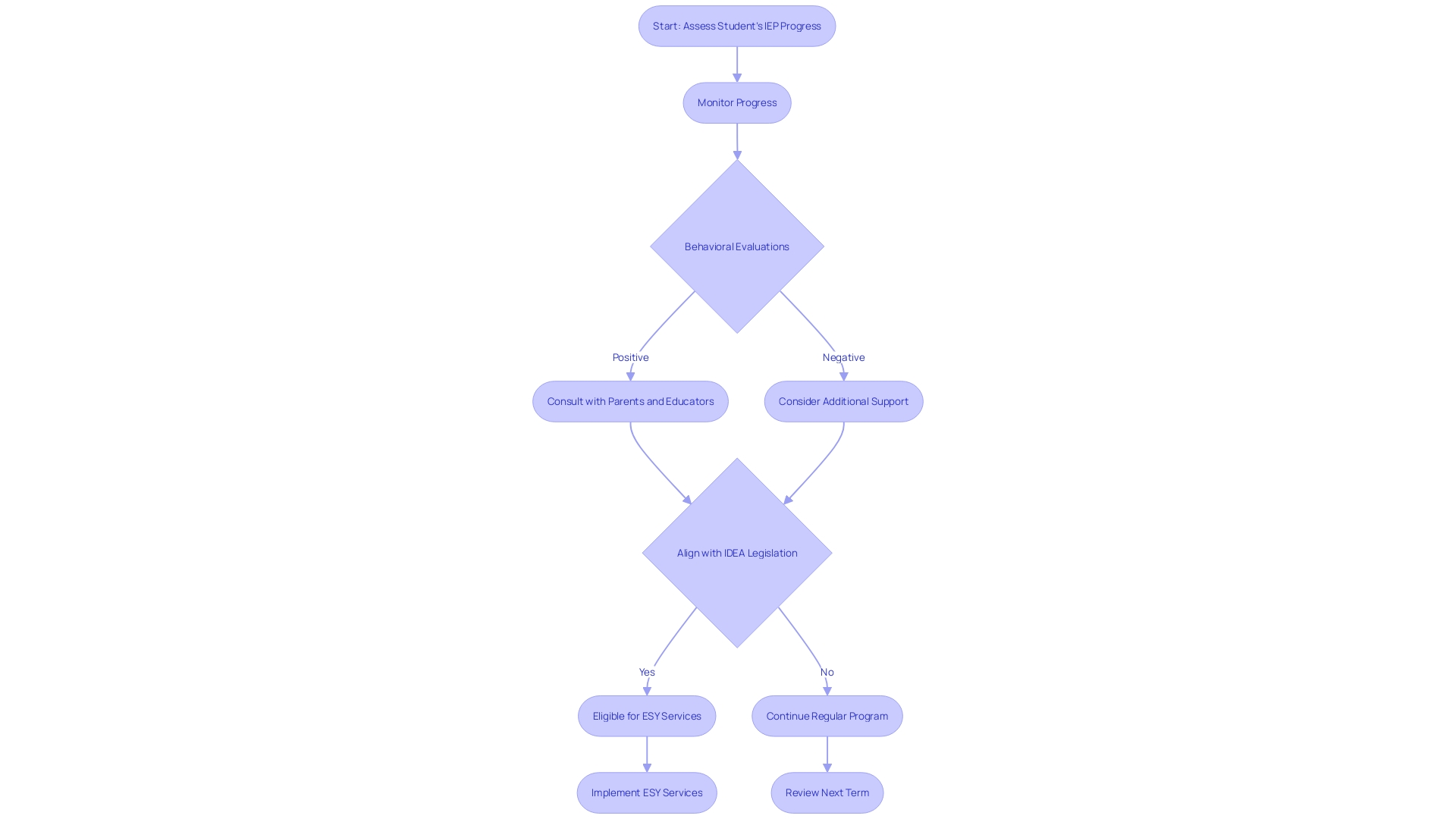
Key Factors in ESY Eligibility
Determining a child's qualification for Extended School Year (ESY) services is a multifaceted process that must take into consideration various critical aspects. One such aspect is the severity of the child's disability and its implications on their educational experience. Notably, significant behavioral challenges often necessitate continuous support to prevent regression. It's equally important to focus on sustaining progress in pivotal developmental areas, such as communication, socialization, and academics.
The student's rate of progress and the intricacies of their educational goals are additional factors that require thoughtful evaluation. Moreover, the availability of alternative support services outside of the school setting may influence the decision-making process regarding ESY eligibility.
It is imperative to engage in collaborative discussions that include parents, educators, and ABA therapy professionals to reach a comprehensive and equitable determination of ESY services. This collaboration ensures that all perspectives are considered, particularly the nuanced needs and potential of the child in question. The ultimate goal is to foster an environment that supports the child's ability to thrive both during the school year and beyond.
As the educational landscape evolves, the need for innovative approaches to support children with disabilities becomes even more apparent. Recent initiatives, such as the Pathways to Partnerships model demonstration project funded by the U.S. Department of Education, aim to enhance post-school outcomes for these children. By fostering systemic collaboration among various agencies and independent living centers, these efforts underscore the importance of a coordinated strategy to facilitate a seamless transition into adulthood and the workforce for individuals with disabilities.
In summary, a holistic approach to determining ESY eligibility is critical for ensuring that children with disabilities receive the necessary support to maintain and build upon their educational achievements, ultimately paving the way for a more inclusive and empowering future.
Data Collection and Analysis for ESY Determinations
Ongoing progress monitoring and the systematic collection of data are pivotal in shaping informed decisions regarding Extended School Year (ESY) eligibility for students. Objective data collection facilitates the accumulation of evidence on a student's performance, skill acquisition, and behavioral patterns. Such data not only charts progress over time but also uncovers trends, strengths, and potential areas for improvement. A close examination of this data equips educators and ABA therapy professionals with the insights needed to discern a student's need for ESY services. Moreover, it allows for the customization of interventions to address the unique requirements of students during prolonged school breaks.
Synthesis of research, particularly nonpharmacological intervention studies for children and youth on the autism spectrum, reveals a pattern of design flaws that obscure the understanding of the interventions' impact, including their effectiveness and potential side effects. This underscores the importance of rigorous data analysis in ESY decision-making. It also aligns with the advocacy by the autism community over recent decades for improved research quality and reporting standards, which is seen as a fundamental aspect of respecting individuals with autism.
A New York state-licensed and Board-Certified Behavior Analyst, with over a decade of clinical experience, emphasizes the significance of technology in enhancing care coordination. Her work in creating technology solutions for providers and health plans ensures that care is delivered following best practices, demonstrating the role of innovative approaches in streamlining the care process.
When considering interventions for young children with autism, the rewards are manifold. As one researcher puts it, witnessing children's developmental breakthroughs, whether in communication or social play, brings immense satisfaction to the entire research team. These successes highlight the importance of tailored interventions that can support the diverse needs of children with autism, particularly during times when traditional school services are not available, such as during easy periods.
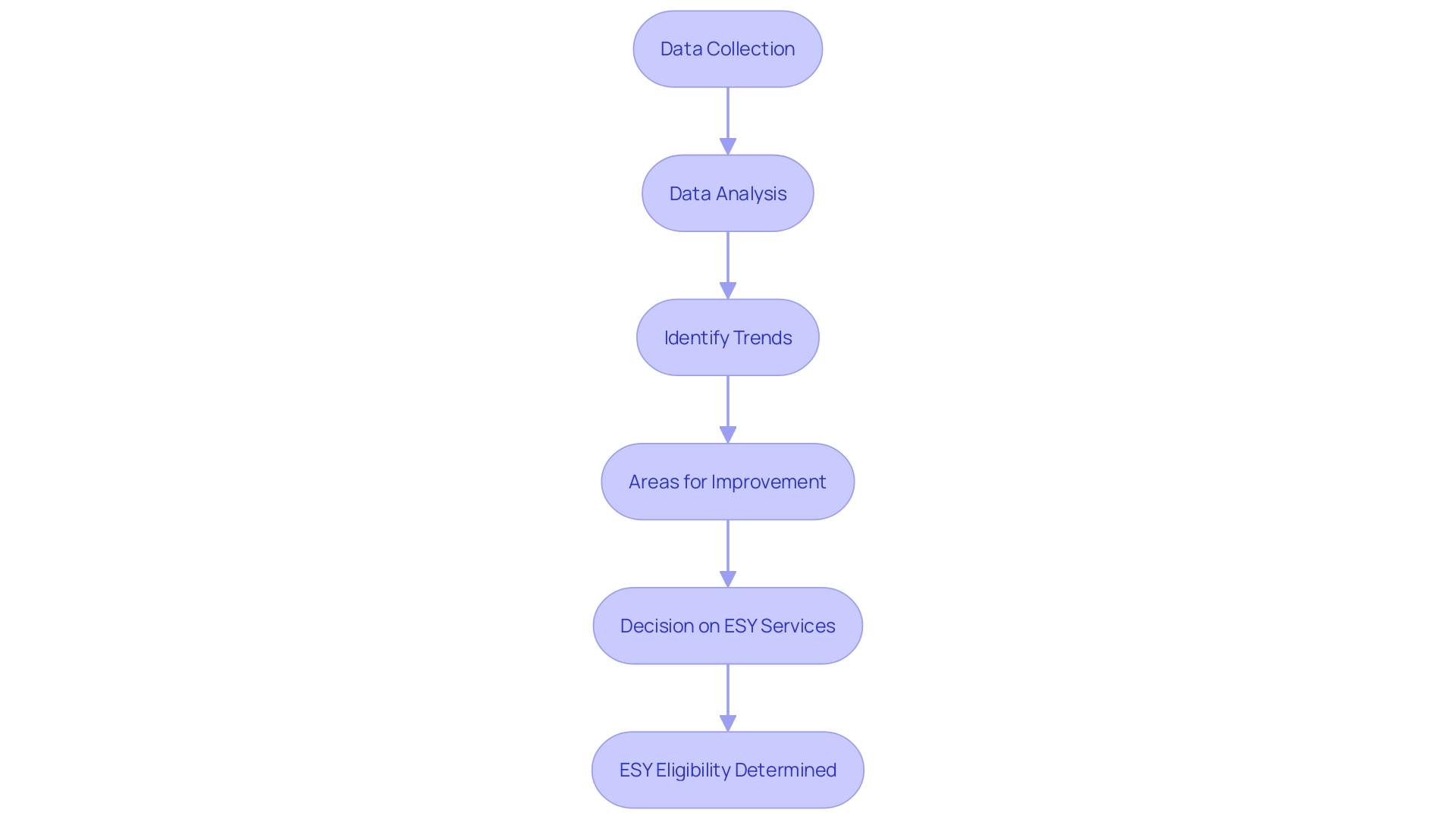
Setting Effective ESY Goals and Objectives
To truly optimize Extended School Year (ESY) programs, it's vital to set goals that are not only SMART—specific, measurable, achievable, relevant, and time-bound—but also deeply integrated with each student's unique learning journey. By crafting goals that resonate with the student's individualized education program (IEP), we focus on pivotal development areas that propel students forward. Achieving this requires breaking down objectives into small, manageable steps, which enables consistent monitoring and adjustments as needed.
The collective expertise of parents, educators, and ABA therapy specialists is a powerful force in setting such goals. A New York state-licensed Board-Certified Behavior Analyst emphasizes the importance of coordinated care through the use of technology solutions that streamline the review process and ensure high-quality outcomes for all parties involved. This collaborative approach, which values each partner's competence equally, is echoed in the resources provided by the National Center for Systemic Improvement (NCSI), advocating for meaningful parent engagement and recognizing the unique knowledge parents and professionals bring to the table.
When we engage parents and professionals in the goal-setting process for ESY programs, we're not just planning for the near term; we're building a foundation for lifelong success and continuous improvement. As statistics show, a significant barrier to meaningful engagement and connectivity is the lack of digital skills. By providing parents and educators with the tools and resources to navigate the digital landscape, we can overcome this obstacle and establish a more connected and effective learning environment for students. The American University of Greece's Learning Design and Technology master's degree program offers valuable insights on how to blend various learning theories and approaches to create a multifaceted learning experience, which can be adapted to support ESY goal-setting.
Incorporating these principles ensures that ESY goals are not only well-defined but are also attuned to the complex dynamics of learning, making them more meaningful, realistic, and conducive to positive student outcomes.
Creative Strategies to Enhance ESY Programs
To truly enhance Extended School Year (ESY) programs, it's essential to weave in imaginative and engaging strategies that resonate with students, making their educational experience not only enjoyable but also deeply impactful. This involves a blend of hands-on activities that connect with real-world applications and interactive games that make learning dynamic and stimulating. The creation of an inclusive, supportive atmosphere is key, where every student feels encouraged to actively participate and invest in their learning journey.
Incorporating technology and digital tools further enriches ESY programs, equipping students with a variety of resources that support practice and learning reinforcement. For instance, integrating environmental themes, such as earth, ecology, and water quality, can transform abstract concepts into tangible learning experiences, as seen with the use of permeable paver lots to teach sustainability.
Moreover, educational courses like 'Basics of Climate Change' and 'Climate Fiction in Literature' demonstrate how literature can become a powerful tool to engage students in complex subjects like climate change. Place-Based Learning connects students to their local environment, making the impact of climate change on their immediate world more relatable and urgent.
The philosophy of lifelong learning, as embraced by the teachers at Evelyn Scott School, underscores the importance of fostering skills like creativity, collaboration, problem-solving, and critical thinking. Joyful curiosity and structured inquiry are crucial in delivering personalized learning, as guided by frameworks like Future Focused Learning and the ACT Future of Education Strategy.
Statistics underscore the untapped potential of creativity, with 75% acknowledging the need to harness their creative abilities, yet only 25% feeling they are maximizing their creative potential. This gap indicates a significant opportunity to explore new creative avenues. Surprisingly, 72% of individuals find creative inspiration in everyday activities like showering, highlighting the spontaneous nature of creativity.
Experts emphasize the importance of solution-focused approaches, where engaging with creativity through expressive arts can lead to finding new solutions to old problems. This approach aligns with the vision of children learning science best by 'doing' science and engineering, fostering a more meaningful, equitable, and lasting education.
In summary, the evolution of ESY programs hinges on a multifaceted approach that integrates creativity, technology, and a nurturing learning environment. By adopting these strategies, we can empower students to explore, discover, and learn in ways that prepare them for the challenges of tomorrow.
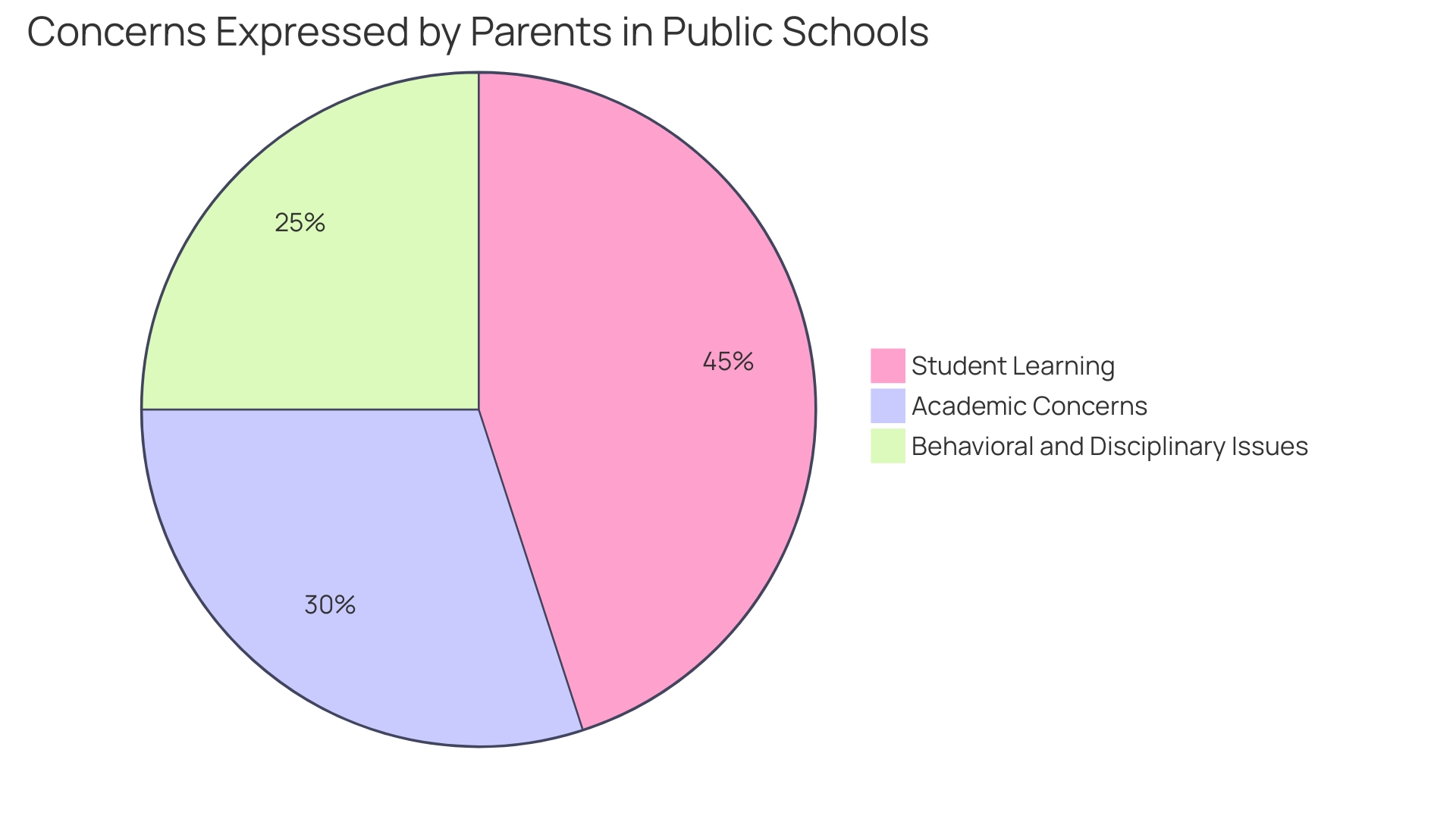
Parent Communication and Involvement
In Extended School Year (ESY) programs, the synergy between parents and ABA therapy professionals is crucial for shaping a supportive environment that caters to the unique needs of students with autism. By engaging in continuous dialogue, parents and educators can align on the student's objectives, monitor their journey, and promptly address any obstacles. This collaborative approach is not only about addressing current needs but also leveraging the strengths and passions of these young learners to facilitate their growth. Incorporating technology solutions that streamline coordination and enhance the quality of care can further solidify this partnership, ensuring a consistent, high-standard approach to each student's progress. It is this collective effort, underscored by the latest ABA practice guidelines and backed by dedicated professionals, that can make the educational 'race' fair and inclusive, enabling each child to thrive in their academic and social endeavors.
Utilizing Teletherapy and Remote Services
The evolution of teletherapy and remote services has revolutionized the way Extended School Year (ESY) programs are delivered, offering a lifeline to students who require consistent educational and therapeutic support but are unable to attend in-person sessions. As a Board-Certified Behavior Analyst with extensive clinical knowledge and experience in technology solutions for coordinated care, the integration of teletherapy into ABA therapy is a significant advancement. These virtual sessions provide real-time feedback and foster collaboration between ABA therapy support specialists, parents, and educators, making support accessible no matter where students are located.
Statistics show that telehealth has surged to the forefront of healthcare delivery. In the wake of the pandemic, the reliance on telemedicine and virtual care became critical, not just as a temporary solution but as a growing trend in the healthcare market. Synchronous telehealth in particular, which enables live audio and video interactions between therapists and patients, has seen widespread adoption across various healthcare fields, including mental health services. This adoption is reflected in the projected increase in demand for speech-language pathologists and occupational therapists, highlighting the importance of teletherapy in meeting the growing needs for support.
Recent news underscores the urgency of this demand, as more than two-thirds of public schools have reported a rise in students seeking mental health services. Programs like Los Angeles County's initiative to offer free mental health services to 1.3 million K-12 students via teletherapy illustrate the critical role of virtual support platforms in addressing the youth mental health crisis.
The benefits of teletherapy extend beyond just accessibility; it also promises to enhance the quality of care through the use of AI and other technological advancements that amplify the capabilities of educators and therapists. The embrace of these emerging technologies is not optional but necessary for the future of K-12 education, enabling practitioners to serve more students effectively with best practices.
By integrating teletherapy into ESY programs, we are not only responding to the immediate needs of students but also paving the way for a more resilient, flexible, and inclusive educational system that can address the mental health challenges of today and tomorrow.
Addressing the Whole Child: Academic and Social Needs
Extended School Year (ESY) programs are vital in nurturing the 'whole child' by integrating social and emotional development alongside academic instruction. The implementation of Applied Behavior Analysis (ABA) within these programs is not just a supportive strategy but a cornerstone for cultivating social competencies. ABA therapy specialists are instrumental in this process, as they enhance social skills, enable peer interactions, and assist in the transference of these skills across various settings.
Emerging from the social model of disability, which views disability as a result of social constructs and barriers rather than individual deficits, ESY programs are designed to challenge the status quo of ableism. The social model suggests that societal change, rather than individual adaptation, is the key to inclusion. This approach aligns with the push towards inclusive education, where students with disabilities, such as autism, are given equitable opportunities to participate and thrive in educational settings alongside their peers.
In practice, this means ESY programs should offer structured social skills training and create inclusive environments that promote the acceptance and valuing of diversity. By fostering an inclusive atmosphere, students are better equipped to form meaningful connections and navigate complex social landscapes. The aim is to shift the focus from requiring individuals to conform to societal standards to adapting society itself to be more accepting and supportive of all its members.
Moreover, recent literature highlights the increasing recognition of social and emotional skills as essential for students' development and societal well-being. This underscores the importance of including these skills within ESY programs to prepare students for life beyond the classroom. As we continue to advocate for inclusive education, it's clear that the legal and cultural foundations support the drive towards a more inclusive society. This includes reinforcing the IDEA and sharing resources to support high-quality individualized programming that recognizes children with disabilities as capable and integral members of early childhood programs.
Ensuring Accessibility: Transportation and Community Partnerships
In the pursuit of enhancing Extended School Year (ESY) programs, a keen focus on transportation logistics and strong community connections is paramount. Making sure that various transport modalities are available for students is crucial to facilitate their seamless participation in ESY activities. This could involve forming alliances with local transport services and exploring innovative ways to mobilize resources. By uniting with local businesses and recreational entities, students gain invaluable opportunities to apply their learned skills within the tapestry of the community, fostering a sense of belonging and practical integration.
Leveraging State Resources and Guidelines
Understanding state-specific guidelines and funding for Extended School Year (ESY) services is crucial to delivering effective ABA therapy. As professionals and parents, it is our duty to navigate these state-mandated regulations and policies to ensure the best possible outcomes for students. By engaging in statewide professional learning communities, as encouraged by initiatives like the Autism Circuit Academy, we can share knowledge and best practices. It is also vital to recognize the evolving nature of state guidelines, as seen with recent federal rules supporting kinship caregivers, which underscore the importance of staying current with legislative changes. Collaboration and coordination, as demonstrated by experts like Dr. Aleksandra Hollingshead, are key in adapting our strategies within the multifaceted roles that state education agencies (Seas) play. Recent studies, such as Timothy Lewis's work on Check-in/Check-out interventions, further emphasize the need to incorporate evidence-based methods in our approach to ESY services, ensuring that we not only comply with state requirements but also embrace the most effective techniques for supporting social, emotional, and academic development.
Beyond the School Building: Community-Based ESY Programs
Expanding the horizons of traditional educational settings, community-based Extended School Year (ESY) programs are carving out a niche in the landscape of student development. These innovative programs, such as the ones highlighted by the Academias Gulbenkian do Conhecimento initiative, harness the power of real-world experiences by integrating field trips and local partnerships to bolster social and emotional competencies in young learners. Students, through these community linkages, are offered the chance to apply and hone their skills beyond the confines of the classroom, paving the way for greater independence and the transfer of learned behaviors to various life contexts.
For instance, through programs similar to the Early College Program (ECP) where advanced learners engage in university field trips and STEM activities, students can visualize the practical application of their academic pursuits. These experiences are crucial, as indicated by the OECD, in not only enhancing educational attainment but also impacting lifelong outcomes.
Moreover, the success of such community-based initiatives is measurable through specific implementation outcomes such as acceptability, adoption, appropriateness, and sustainability. These outcomes are essential to ensure that educational interventions, like those of the Fundação Calouste Gulbenkian's SEL program, are effective and resonate with the community's needs. Just as the Nest program supports Indigenous families through culturally infused direct services, ESY programs are designed to be attuned to the unique demands of the community, fostering a well-rounded and impactful educational journey for students.
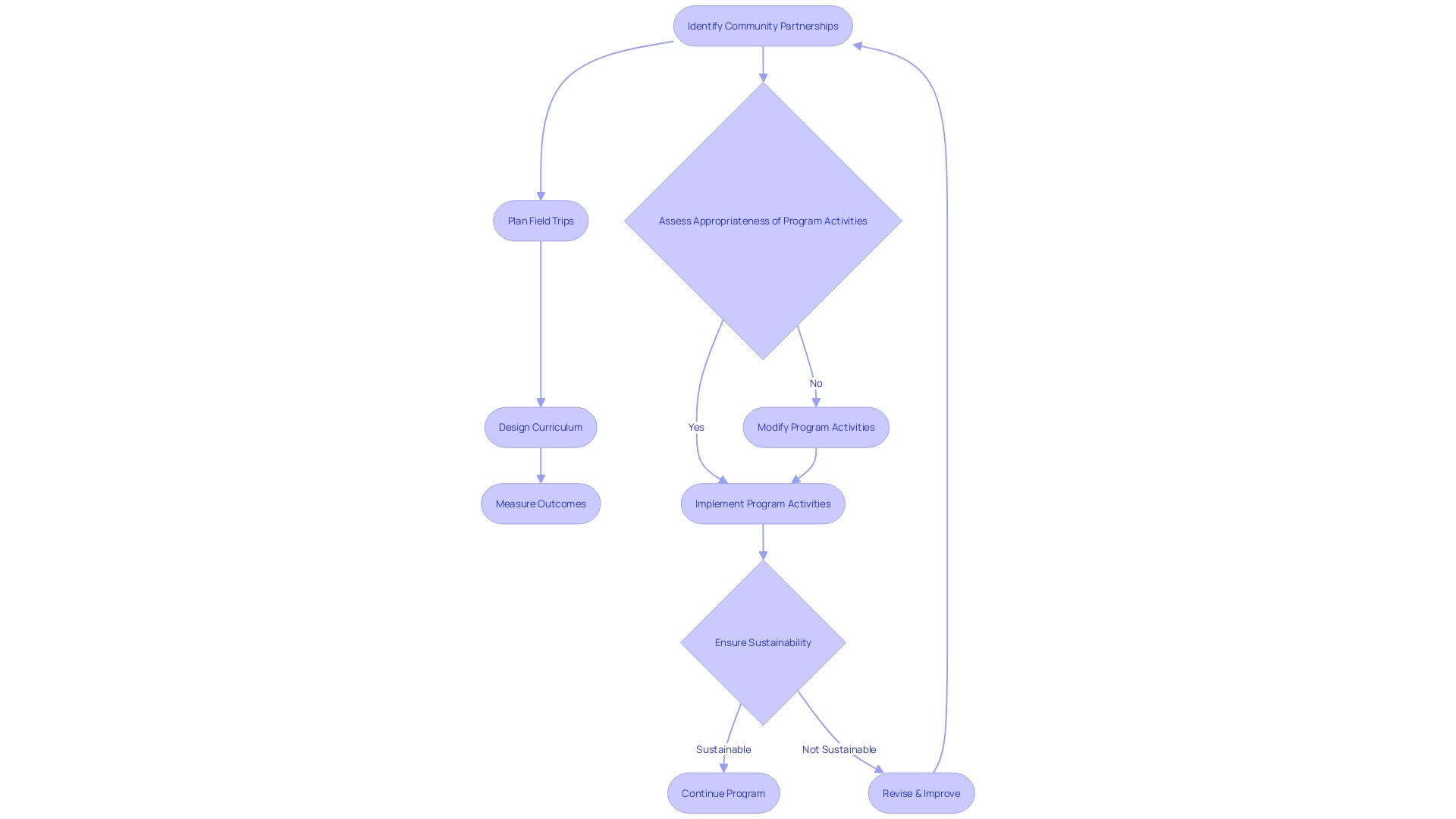
Working with Parents: Decision-Making and Recourse
The role of parents in shaping a fair and equitable educational journey for their children, particularly those with disabilities, cannot be overstated. It's crucial that they have a seat at the table during the Extended School Year (ESY) process. Dr. David (Dan) R. Offord, a renowned child psychiatrist, once said, "I do not mind if my children are in a race as long as the race is fair." This sentiment captures the essence of parental involvement in ESY decision-making, goal-setting, and program design. Their insights, based on firsthand experience, are invaluable in creating an environment that reduces stress and acknowledges the unique strengths of their children.
Recent developments in educational technology (EdTech) and publications offer a plethora of resources that can inform and empower parents in these discussions. Engaging with books and articles on the subject can provide a well-rounded understanding of the best practices in advocating for their children's needs. This is especially critical for families of autistic children who are at higher risk of being marginalized in social settings.
To ensure meaningful participation and equity, it's essential to adopt a collaborative approach that honors mutual competence. Professionals bring technical expertise and systemic knowledge, while parents contribute a deep understanding of their child's requirements and community context. A perfect example of this collaboration is the family group conference technique used in Cornwall, where the entire family comes together to support a child's well-being, highlighting the importance of a collective effort.
Moreover, educational leaders are recognizing the significance of including parent voices in system-level initiatives. Parents are increasingly being involved in advisory boards, policy-making, and service development, which reflects a shift towards family-centered practices.
To navigate any disagreements in the ESY services, parents can resort to the procedural safeguards outlined by the Individuals with Disabilities Education Act (IDEA). This legal structure ensures that parents can voice their concerns and seek resolutions in a formal and structured manner.
Embracing an open dialogue that values transparency and shared decision-making not only empowers parents but also helps to ensure that the educational 'race' is indeed fair for all children, regardless of their abilities.
Conclusion
ESY programs are crucial in ensuring that students with disabilities receive ongoing education and therapy during breaks, preventing skill regression and promoting long-term success. By integrating technology solutions and research insights, these programs can be tailored to better serve students and foster the development of essential social and emotional skills. ESY programs are not a luxury but a necessity in the pursuit of equitable education, providing fair opportunities for every child to thrive.
Determining eligibility for ESY services involves a comprehensive assessment that considers factors such as a child's progress, behavioral evaluations, and input from parents and educators. By utilizing current research and best practices, ESY programs can maintain a high standard of educational continuity and quality care.
Setting specific, measurable, achievable, relevant, and time-bound goals is vital to optimize ESY programs. Collaboration between parents, educators, and ABA therapy specialists ensures that goals are well-defined and aligned with each student's unique learning journey. Incorporating creative strategies, such as hands-on activities and interactive games, enhances the educational experience and promotes meaningful learning.
Effective parent communication and involvement are essential in creating a supportive environment for students with autism. Teletherapy and remote services have revolutionized ESY programs, providing accessible support and real-time feedback for students who cannot attend in-person sessions.
ESY programs not only focus on academic instruction but also prioritize social and emotional development. By fostering inclusivity and offering structured social skills training, these programs enable students to form connections and navigate social situations.
In conclusion, ESY programs play a critical role in supporting students with disabilities, ensuring their educational progress and promoting overall well-being. By integrating technology, research, and collaboration, these programs can be tailored to meet the unique needs of students and provide equitable opportunities for success. ESY programs are a necessity in the pursuit of inclusive education, allowing every child to thrive and reach their full potential.




